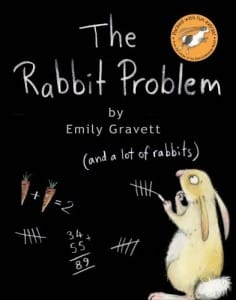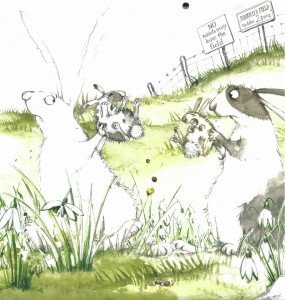Leonardo Fibonacci was an Italian mathematician who, in 1202, became interested in the reproduction of rabbits. His question: under ideal circumstances, if you begin with one male and one female rabbit, how many rabbits will you have in a year? He was 27 at the time, which for that pestilence-ridden era was middle-aged. You’d think he would have better things to worry about than the sex life of bunnies. I’m no mathematician, but after some research I can assure you this question has implications far beyond the comprehension of my flabby and underused left brain. Suffice to say his bunny quandary inspired British author and illustrator, Emily Gravett to write and illustrate the very lovely and delightful, The Rabbit Problem. No need to dust off your calculator. Just enjoy.
Gravett uses the Fibonacci experiment as the starting point to her story, which begins with Lonely Rabbit sending out an invitation for a mate. Chalk rabbit turns up in February, and by March, they have Alfalfa and Angora.
And so on. As with Genesis in the bible, the issue of a limited gene pool from which to select partners for the business of begetting is sidestepped in favour of story progression, and in this particular case, adherence to a famous sequence of numbers. By May, there are eight rabbits, in addition to Lonely and Chalk, just as Fibonacci predicted. Incidentally, Fibonacci introduced the western world to our current number system (0, 1, 2, 3…) Were it not for Fibonacci (via the Indians and Arabs), we would still be using Roman numerals. Somehow I think I’d still suck at math.
Gravett owes a debt to Allan Ahlberg’s The Jolly Postman in the design of the book, which includes letters, pockets, and other clever add-ons. It’s easy to spend a lot of time with this book, opening doors, deciphering scribbles, reading recipes (all of which have just one ingredient…carrots), and falling for Gravett’s wonderfully energetic bunnies as they tumble across the page and wreak havoc in ‘Fibonacci’s Field’, where they live.
The book is actually a calendar, complete with a hole at the top. Each month brings a new set of pressing challenges to the colony: boredom, excessive heat, dwindling supplies of carrots, and literally, an exploding population. The last page is a fabulous pop-up of all 233 (I think) rabbits bursting out of the field, and indeed, out of the book. The Rabbit Problem isn’t just beautiful, it’s a total blast.
Emily Gravett is the author of many splendid books, including a favourite from 2006, the irresistible Meerkat Mail, which employs the same interactive format as The Rabbit Problem.
In the chaos of this story, it’s possible to miss Gravett’s superb skills as an illustrator. The rabbits are absolute charmers with their long ears, receding chins and pendulous noses. She deftly avoids the drippy sweetness that is unfortunately, the rule rather than the exception in the esteemed field of bunny illustration. Instead she creates a colony of unique, and endearingly goofy personalities, all with their own set of bothers, and all fabulously fertile. The illustrations are produced in pencil, watercolour, and rather surprisingly, Photoshop, which she uses primarily as a bunny mover. With this many ears, I don’t blame her.
My friend Loraine gave The Rabbit Problem to me as a birthday present, completely oblivious to the fact that she’d gifted me with Meerkat Mail the year before. In spite of her extensive background in children’s literature, Loraine did not pick up on the fact that both books were from the same artist, a credit to Gravett’s inventiveness, and also to my friend, who has always been able to recognize a picture book I will love from miles away. Thanks Loraine.
The Rabbit Problem by Emily Gravett, MacMillan, 2009 ISBN: 978-0230704237 (hardcover)
Also, Meerkat Mail, MacMillan, 2006 ISBN: 1405052155 (hardcover)
Emily’s creative process is nicely summarized in a short video of Gravett in her studio.
Also, as one would expect, Emily Gravett has a fantastic website. Visit and enjoy!




